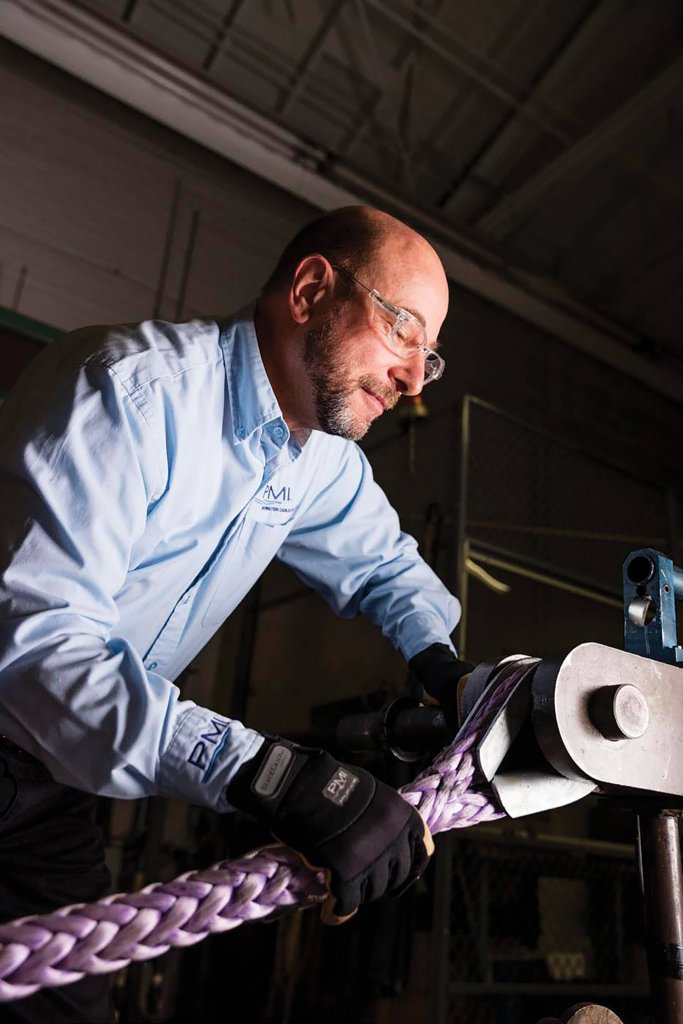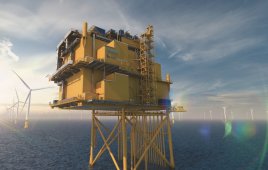Now that the U.S. offshore wind sector has one working wind farm and more projects in the pipeline, it’s a good time to start thinking about the future of the subsea cables that transmit electricity to the mainland grid.
Tyler Burger / Project Engineer and Marine Energy Specialist / PMI Industries Inc.
Cables are often treated as an afterthought in offshore wind farm development — but cable damage accounts for as much as 80% of insurance pay-outs on these projects.

PMI Lab Manager Jay Marino installs a synthetic rope sample for tension testing to ensure compliance with its rated breaking strength.
I’ve learned this first-hand through work on the engineering team at PMI Industries in Cleveland, Ohio, where we build premium accessories for subsea transmission cables and sonar-array cables used to hunt for oil and gas deposits. Our experience in the hydrocarbons industry gives us a perspective on the role of subsea cabling in offshore wind along with wave and tidal technologies.
We’ve been talking about subsea cabling challenges for the past few years on our Ocean Engineering Blog and thought it time to write about the future of cables in offshore wind projects. Hence, this article. But before we start predicting the future, let’s confront the present.
Unique challenges for subsea cables
No matter how much time, money, and energy a company devotes to developing offshore wind farms, it’s all for naught if the electricity cannot reach the mainland grid. Subsea cabling could become the weak link in an offshore wind farm.
From what we have seen, here are the main cabling issues the offshore wind industry faces:
Changing ocean terrain − It is possible to bury transmission cable according to plan, but the subsea terrain can shift in as little as six months. Or, an underwater landslide can leave the buried cable exposed, increasing the risk of damage and corrosion.
Unpredictable weather − Imagine that an underwater landslide is severe enough to cause a cable malfunction. Now you have to hire a ship and crew to find the source of the malfunction and fix it as soon as possible. But bad weather may delay repairs for weeks or months, depending on the locale of the wind farm and site of the breakdown.
Cable characteristics − Transmission cables are designed for a static application so they have little elasticity. Stresses and strains from ocean currents, installation, and repair processes can stretch cables to their breaking point.
Thermodynamics − Transmitting electricity over cables creates heat. Even though the cables typically pass through cool or cold water, the contrasting temperatures can cause wear or produce other unanticipated flaws.
Complex repairs − Cables usually suffer two kinds of damage: physical breakage and performance degradation. Of the two, physical breakage is somewhat easier to fix because it is possible to find the two ends, haul them up to a ship, splice them together, and get the cable back in operation. With performance degradation, it is necessary to find the exact location of the fault on an intact cable before starting repairs, and that is a much tougher bit of detective work.
Monitoring − Portable, unmanned, underwater vehicles are becoming essential to examining subsea cable locations and diagnosing problems. Technology is also getting better at monitoring the entire subsea cable grid and providing alerts when faults crop up.
Downtime expense − Given the high cost of offshore wind development, wind farm managers must hold the line on downtime because lost electricity flow means lost revenue from the grid operator. Given the inherent delays from weather, availability of repair vessels, and difficulty tracking down the source of cable problems, engineers must make sure they’re doing all they can to prevent cable woes during the design phase of a project.
That’s enough on the problems. Let’s move on to the future possibilities for subsea cables.
Offshore wind cabling: What’s on the horizon
The future of offshore wind lies beyond the view of beachgoers, many of whom consider offshore wind farms an eyesore. This is a big deal in North America because so many coastal areas depend heavily on tourism. With that in mind, these factors should have the greatest influence on offshore wind cabling in the years to come:

PMI Engineer Terrence Mathis reviews test data at the company’s dynamic tension test machine controller console. Here, test parameters can be programmed for data such as tension, elongation, torque, rotation, torque balance, twist resistance, and more.
Floating platforms − Installing wind turbines on floating platforms solves a host of problems. For example:
• Coastal views remain scenic because floating platforms can be installed beyond the view of beachgoers.
• Stronger winds farther from shore produce more electricity and with greater reliably.
• Installations are simplified because they are floated into place.
• Turbines are easier to repair and decommission because they’re mobile.
• Floating wind farms can be installed in much deeper water than their solid-foundation counterparts, opening development opportunities in regions with narrow continental shelves, such as those off the coasts of California and Japan.
However, floating wind farms are more costly than existing technologies and installation techniques. These are preventing wider adoption.
But what about the cables? As you can imagine, a turbine platform moving with the waves will require dynamic transmission cables that can adjust to the platform’s motion. As noted earlier, current transmission cables are static. They are put in one location and hopefully stay there. Commercial-scale floating platforms will require innovations in dynamic power cabling.
Automation − Could floating platforms essentially install themselves — cables and all? Most likely, yes. Many cabling installation and repair jobs require teams of divers, presenting risks that translate into high costs, which automation could reduce in two areas:
• Advanced subsea vehicles. Autonomous and remotely operated mini-subs can do a lot of underwater work without exposing divers to the risks of the ocean environment.
• Self-connecting and disconnecting cables. Connecting cables to devices is often done manually. But because these operations are essentially mechanical and repetitive, they can be automated.
As these technologies mature through use in other industries, they’ll give offshore operators more opportunities to shave costs and become more competitive with fossil fuel power.
Internet of Things (IoT) − Pervasive networked sensors are becoming more common in manufacturing operations, and this will likely happen in offshore wind as well. Sensors can be developed to monitor the electricity flow on specific lengths of cable and send telemetry data to a central processing hub that will monitor everything happening on an offshore wind farm in real time.
Software can be written to detect subtle changes in current that indicate a cable has a flaw that can be repaired on a schedule rather than on-the-fly in an emergency, which is naturally much more expensive. Data could be transmitted via satellite to avoid the possibility of losing data to a damaged cable.
The combination of automation and constant monitoring could make it possible to pre-configure a floating wind farm near shore, tow it out to a specific anchor point, and connect it to the grid with much lower potential for human error, creating more opportunities for economies-of-scale that make these wind farms more viable.

A PMI helical rod cable termination is installed in a testing machine to sample the termination’s dynamic tension capability and measure its maximum grip.
Synthetic cables − High-tech synthetic fibers such as aramid provide the strength of steel at a fraction of the weight, which makes them an alluring option in a host of subsea applications, including power cables. They’re easier to handle and not as susceptible to corrosion as steel-armored cables.
While these benefits will help synthetics make inroads against traditional steel cabling, there is one caveat: Adding an attachment point (a “termination” in our trade) can cause a synthetic cable to lose up to half of its tensile strength. At PMI, we addressed this challenge by designing a “strength member termination” that can preserve up to 75% of the cable’s tensile strength. Terminations for steel cables preserve all of the cable’s tensile strength, which can be a point in favor of sticking with steel.
Additive manufacturing − Additive manufacturing is a fancy term for 3D printing, which starts with a three-dimensional image on a computer that is connected to a device that builds the object one thin layer at a time. Most 3D printers work with plastics, but parts also can be printed done with metals.
This creates the potential to build spare parts on the fly rather than wait for them to be shipped in from far-off locales, which would cause delays of days or weeks. Of course, there are lots of particulars to be worked out — to print parts on site you must have the proper raw materials, whether they be plastic, steel, or a composite that hasn’t been invented yet. But as 3D printing moves further into the mainstream, it stands to reason that the devices and the materials they use should evolve in unison.
Good things on the horizon
Offshore wind is one tiny blip on the U.S. coastline today, but it won’t be that way forever. As manufacturing, development, and installation costs fall thanks to the maturing European offshore wind market, it seems certain that U.S. offshore wind development will accelerate in the next few years.
It’s sure to be a great ride for wind-power engineers. Just don’t neglect your cables.
Filed Under: Cables & connectors




